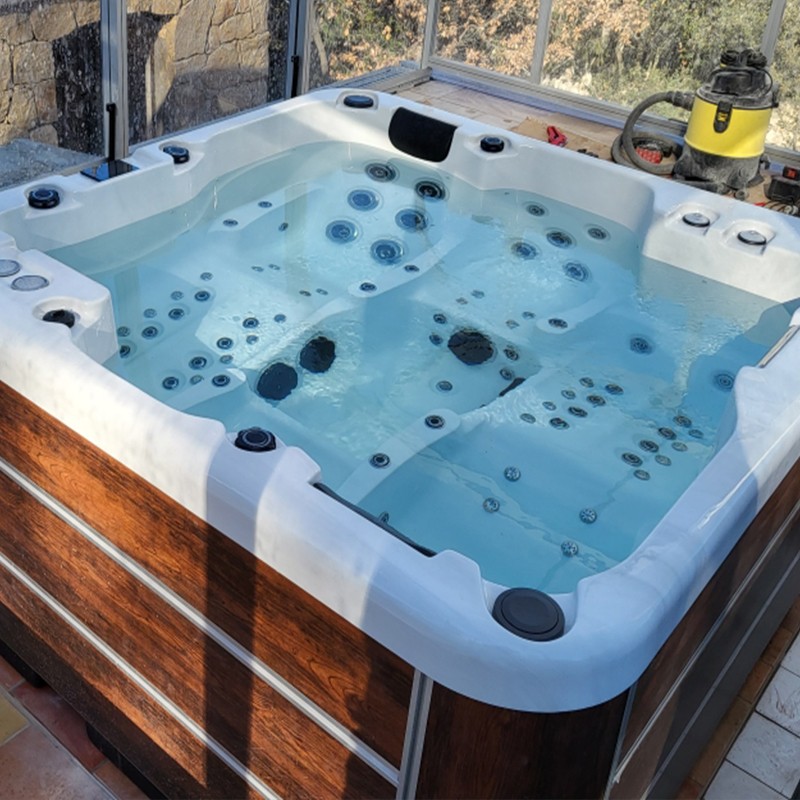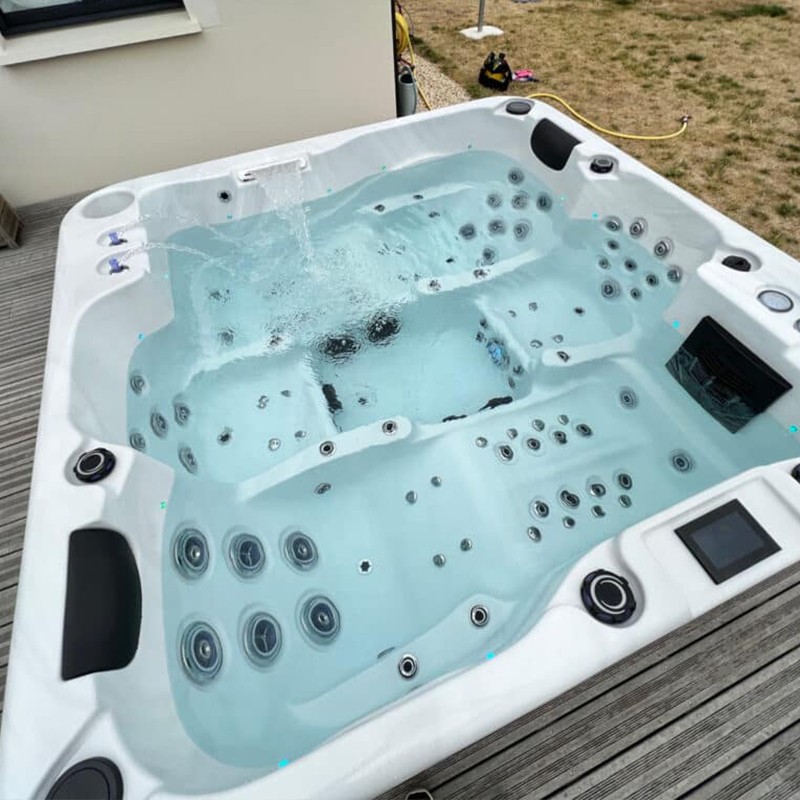
Can I Leave Water in a Whirlpool Tub?
2024-10-02 15:30Whirlpool tubs are known for their unique water massage function and relaxing experience. Many people may consider a question after using them: "Can I leave water in a whirlpool tub?" After all, re-draining and refilling may seem troublesome, and leaving water in seems to save time and water resources. However, this issue is not only about convenience, but also involves many factors such as hygiene, equipment maintenance and energy consumption.
This article will systematically analyze the question of whether water can be left in a whirlpool bathtub, and discuss it in detail from the perspective of hygiene, the impact of equipment and the convenience of actual operation.

What is the structure of a whirlpool bathtub?
Whirlpool bathtubs are usually equipped with multiple jets, which use a water pump to pump water into the bathtub and then spray it out through the nozzles to form a water massage effect. This system relies on clean, uncontaminated water flow to ensure the best user experience and the normal operation of the system. If the water in the bathtub is retained for a long time, it will not only cause damage to the equipment, but also affect the life of the jets and water pumps.
What is the role of the water circulation system?
The water pump and filtration system are the two core components of the whirlpool tub. Water is circulated through a filtration system, and the filter can capture impurities in the water to ensure that the water sprayed out is clean. Generally speaking, whirlpool tubs are not designed to retain water for a long time. Although there is a filtration function, it is not enough to ensure that the water retained for a long time will not be contaminated by bacteria. Therefore, for whirlpool tubs, the cleanliness of the water is crucial.
Can I leave water in a whirlpool tub?
Issues with water left in a whirlpool tub:
1. Hygiene issues: risks of water being retained for a long time
2. Equipment impact: potential damage to whirlpool bathtubs
3. Energy consumption issues: how retained water increases energy consumption
Hygiene issues: risks of water being retained for a long time
Potential for bacterial growth
If you leave water in a whirlpool tub for a long time, the most direct risk is bacterial growth. The warm water environment provides an ideal breeding ground for bacteria and other microorganisms. Especially without continuous water flow and disinfection measures, microorganisms will multiply rapidly. This may include Legionella, fungi, mold, etc., which may cause skin infections, respiratory problems or even more serious health problems in the water.
Legionella is of particular concern, as this bacteria thrives in warm water and spreads through the air. Using a whirlpool with contaminated water can lead to a respiratory infection known as Legionnaires' disease. This infection can be particularly dangerous to people with weakened immune systems.
Deterioration of water quality
Water that has been in a whirlpool for a long time can gradually deteriorate due to contamination. Even if the water still looks clear, it may have begun to accumulate sweat, sebum, soap residue, and other impurities. These impurities not only affect the cleanliness of the water, but can also clog nozzles and filters, reduce the massage effect of the whirlpool, and even cause system failure.
Disturbance of chemical balance
Another important factor in water quality is chemical balance. The water in a whirlpool needs to maintain the proper pH and disinfectant concentration to ensure it is safe and effective. If the water is not changed for a long time, the pH may become unstable, causing the water to be too acidic or too alkaline, which is not only harmful to the skin, but can also corrode the internal components of the tub. In addition, the concentration of disinfectants (such as chlorine or bromine) will gradually decrease over time, further increasing the risk of bacterial growth.

Equipment Impact: Potential Damage to Whirlpool Tubs
Wear of Pumps and Jet Systems
Leaving water in the tub for long periods of time can cause excessive wear on the pump and jet systems. As impurities and minerals in the stagnant water slowly settle in the pump and pipes, it can cause nozzle blockage, increase pump load, and ultimately shorten the life of the equipment. Cleaning and maintaining these systems can cost much more than regular draining.
Accumulation of Hard Water Sediments
If your area has hard water, minerals in the water, such as calcium and magnesium, can settle over time in the tub and pipes, forming scale. The buildup of scale can affect the jet function of the nozzles, reduce the massage effect, and increase the risk of pipe blockage. Scale can also make cleaning the tub more difficult, requiring the use of specialized descaling agents or professional cleaning tools.
Aging of Seals and Pipes
Water stagnating in a whirlpool tub for long periods of time can also cause accelerated aging of seals and pipes. Seals are key components to prevent water leaks, and if left in water for a long time, especially in water with an acid-base imbalance, seals may become brittle or corroded, increasing the risk of tub leaks.
Energy Consumption: How Stagnant Water Increases Energy Consumption
Energy Consumption to Maintain Water Temperature
If you choose to retain water in your whirlpool bathtub and want to enjoy the comfort of a warm bath at all times, you must consider the energy consumption required to maintain the water temperature. Most whirlpool tubs have a heater that is responsible for keeping the water temperature within the ideal range. The heater needs to run continuously to compensate for the drop in water temperature, especially in low ambient temperatures, which will undoubtedly increase electricity costs.
Continuous Operation of the Filtration System
To prevent water quality from deteriorating, the filtration system may need to run continuously. This will further increase energy consumption, because the water pump and filtration system require electricity to keep the water circulating and purified. If the filter is working for a long time, the filter element may also need to be replaced or cleaned more frequently, further increasing maintenance costs.

Practical Convenience and Feasibility
Simplicity of Regular Water Changes
While re-draining and refilling may seem troublesome, in fact, the design of modern whirlpool bathtubs makes draining and refilling relatively simple. Most whirlpool tubs have a quick drain device that can completely drain the water in a few minutes. Refilling water can also be done quickly by connecting a tap or using a heater. Therefore, changing the water regularly should not be seen as a tedious operation, but rather a necessary step to ensure the hygiene and proper function of the bathtub.
Necessity of cleaning the bathtub
If the water in the bathtub is not changed for a long time, cleaning will become more complicated. Stagnant water can cause dirt, soap residue, and human excretions to accumulate on the surface of the bathtub and around the nozzles, which may form difficult-to-remove dirt after the bathtub dries. Cleaning the dirt left behind by stagnant water may be more time-consuming and laborious than changing the water regularly.
How to properly maintain a whirlpool tub?
Most experts recommend changing the water in the whirlpool bathtub after each use, especially when soaking for a long time or multiple people use it. If the bathtub is only for personal use and the water quality is relatively stable, the water can be retained for a shorter period of time, but should not exceed 24 hours. Keeping the water clean not only helps prevent bacterial growth, but also prolongs the life of the bathtub.
In addition, to use the right cleaning agents, whirlpool tub cleaning should include regular use of specialized cleaning agents, especially cleaning the pipe system. These cleaning agents can effectively remove scale and bacteria in the pipes and prevent water quality from deteriorating. If you decide not to use the bathtub for a while, it is recommended to drain it thoroughly and treat the internal pipes with a desiccant to ensure that no moisture remains.
